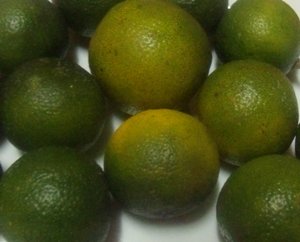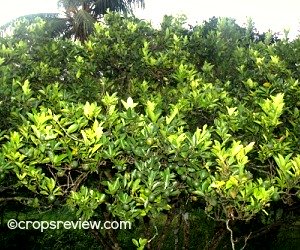The calamondin tree ( x Citrofortunella microcarpa, syn. Citrus microcarpa, Citrus mitis and x Citrofortunella mitis), is also known as China orange and golden lime; calamansi, kalamansi, kalamonding and limonsito in the Philippines; jeruk peres, jeruk kasturi, and jeruk potong in Indonesia; limau kesturi and limau chuit in Malaysia; and sommapit, somchit and manao-wan in Thailand.
This fruit crop probably originated in China as a result of the natural crossing between mandarin and kumquat.
It is now widely grown in India and all over South and Southeast Asia, and almost everywhere. In some countries, it is a popular house plant.
This plant is a shrub or small tree with a long taproot, 2-7.5 m tall.
Trees grown from seed start fruit production 5-6 years after planting, but this is shortened to 3 years or less by planting asexually propagated seedlings.
Flowering and fruiting are year-round, with a peak harvest season lasting for 3 months which falls during the months of August to October in the Philippines.

The calamondin fruit is well known for its acid juice which is used as a flavoring for dishes comprising seafood and meat.
Commercially, this sour-tasting juice is processed into concentrate, drinks, and various products.
Fruits are round, greenish-yellow with a diameter of about 2-4 cm, and reach full maturity in about 5 months after flowering.
Like those of other citrus species such as pummelo and mandarin, the fruit is rich in phosphorus, calcium, iron, and vitamin C.
A 3-year-old calamondin tree may yield 0.75 kg of fruits. A 6-year-old tree may bear up to 5000 fruits with an average yield of 10 kg; a 10-year-old, 50 kg.
Soil and Climatic Adaptation
This fruit crop is adapted to warm climates but it can also grow in cool, frost-free areas.
It can grow in any soil type but prefers a well-drained, sandy, or clay loam soil rich in organic matter, pH 5.5-7.0, in locations with an annual rainfall of 1500-2000 mm.
It has moderate tolerance to drought and shade but cannot tolerate excessive moisture and strong winds.
Plant Propagation

Propagation can be by seed or by asexual methods. Seedlings raised from seed are true-to-type.
However, growth is slow and the trees are spiny.
Clonal seedlings can also be propagated by stem cutting, air layering or marcotting, budding, and grafting.
For large-scale production, shield and chip budding, cleft or wedge grafting, and rooting of stem cuttings under continuous mist or in a non-mist propagation chamber have been practiced.
For growing in the backyard or in containers (pots), air layering or marcotting is recommended.
Marcotted calamondin trees are spineless with small stature and readilly bear fruits. (Click to read on the separate window the procedures in marcotting)
Calamondin can be grown in pots
For pot planting, any container can be used depending on preference based on such considerations as durability, aesthetics, cost, and final size of the tree.
Pots with a top diameter in excess of 8 inches (20.3 cm) are generally recommended for shrubs.
Potting can be started with small pots and progressively changed to bigger ones as the plant becomes bigger.
The potting medium should be fertile, rich in organic matter, and loose, which can be obtained by mixing topsoil, sand, and compost.
If grown as a houseplant, sufficient light should be provided.
REFERENCES
http://www.da.gov.ph/tips/calamansi.html, accessed December 26, 2010.
Verheij, E.W.M. and R.E. Coronel (eds.). 1992. Edible fruits and nuts. Plant Resources of South-East Asia No. 2. Bogor, Indonesia: Prosea Foundation. pp. 117-119.
I Plant Fruit Trees I Calamondin Cultural Practices I Citrus Greening Disease I
